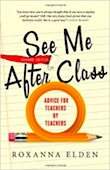New Teachers: Look for PD in Everyday Life
Roxanna Elden’s Disillusionment Power Pack – a month’s worth of friendly email insights – has helped hundreds of novice teachers get more centered in their first year of teaching. She shares a sample of that free advice here!
 By Roxanna Elden
By Roxanna Elden
If you’re paying attention, the elements of good instruction can be found in many experiences that are already a part of your life.
The real-life situations below might improve your teaching more than that stale session in the auditorium. And they don’t involve a single PowerPoint slide.
Workout classes
Group exercise classes can teach us a lot about motivation. After all, how often do you see people doing Zumba or Ab Bootcamp moves on their own? If you attend workout classes you like, watch what the instructor does to keep everyone focused. How do they raise the energy level? How do they keep exercisers from slacking during a workout? How do they keep you from skipping class?
Answering these questions lets you build teaching skills while you build muscle tone. (You overachiever, you!) Another thing workouts teach us is that motivators vary from person to person. If you prefer to work out solo, or if you only hit the gym during New Year’s resolution week, you’ve got a new way to empathize with the introverted or reluctant students in your classroom.
Stores
 Every time we walk into Target, we (okay, I) feel compelled to buy at least one pair of pajama pants. And a funny t-shirt. And hey, maybe some gummy worms from the checkout line. This is no coincidence. Stores design every inch of space to place items where consumers are likely to buy them.
Every time we walk into Target, we (okay, I) feel compelled to buy at least one pair of pajama pants. And a funny t-shirt. And hey, maybe some gummy worms from the checkout line. This is no coincidence. Stores design every inch of space to place items where consumers are likely to buy them.
Your classroom design can also work in your favor. What should students be able to grab easily as they walk in? What do you want them to see when their eyes wander toward the clock? How they can access the file folders or classroom library without bumping into one another? If you need additional inspiration, sit at a student desk while you make decisions or try running through classroom routines yourself.
Comedy clubs
 If you ever attend an amateur comedy contest, you’ll notice that beginning comics face some of the same behavior issues that pop up in your classroom.
If you ever attend an amateur comedy contest, you’ll notice that beginning comics face some of the same behavior issues that pop up in your classroom.
Sure, the audience members are adults, but they’ve been drinking, and drunk people can be a lot like kids: They have short attention spans. They don’t always realize how loud they are talking. And sometimes…. you have to walk them to the bathroom. (Thanks. I’ll be here all week.)
As with teaching, experienced comics can make “owning the room” look easy. That’s because they’ve had years to practice fundamental skills like timing and body language. They’ve also developed seemingly spontaneous responses for the guy yelling, “I already heard that one!” from the back of the room. Just remember that every top comedian was a beginner once. So was every master teacher.
Airports
 If there is one place besides the classroom where crowd control is crucial, it’s at the airport. Everyone who walks into an airport must follow every procedure, every time. No one explains why we have to take off our shoes or remove your laptop from its case; they just repeat the directions. We cooperate because deep down, we want airport security to be able to do its job.
If there is one place besides the classroom where crowd control is crucial, it’s at the airport. Everyone who walks into an airport must follow every procedure, every time. No one explains why we have to take off our shoes or remove your laptop from its case; they just repeat the directions. We cooperate because deep down, we want airport security to be able to do its job.
The same goes for your classroom. Your students – at least most of them – want you to be able to teach. That TSA mindset can provide extra confidence as you demand that the aisles are clear, electronics are stowed, and everyone is seated in an upright position.
Assembling furniture
 Creating a finished product can be a source of satisfaction – or frustration. As with furniture assembly, the more visual, well ordered, and clear the directions are, the more likely the experience is to be a positive one.
Creating a finished product can be a source of satisfaction – or frustration. As with furniture assembly, the more visual, well ordered, and clear the directions are, the more likely the experience is to be a positive one.
If students seem confused the first time you give directions, walk through the steps in more detail. Demonstrate. Draw examples on the board. Have the students who get it help their neighbors. The activity may take more time than you planned, but at least it will keep students from feeling the way you feel when that new bookcase ends up with one backward shelf.
Look for those hidden lessons
Once you start to look for hidden teaching lessons, you’ll find them in the places you least expect. And who knows? If you’re listening hard enough, you might even learn something from that PowerPoint presentation in the auditorium.
Where have you spotted a hidden PD lesson? Share in the comments!
See all of Roxanna’s tips for new teachers.
__________________________________________________
 Roxanna Elden is the author of See Me After Class: Advice for Teachers by Teachers. She is also the creator of the Disillusionment Power Pack, a free, one-month series of emails for new teachers in which she shares journal pages, stories, and insights she would have shared with the first-year-teacher version of herself. Emails begin with signup and arrive every few days for one month.
Roxanna Elden is the author of See Me After Class: Advice for Teachers by Teachers. She is also the creator of the Disillusionment Power Pack, a free, one-month series of emails for new teachers in which she shares journal pages, stories, and insights she would have shared with the first-year-teacher version of herself. Emails begin with signup and arrive every few days for one month.

































